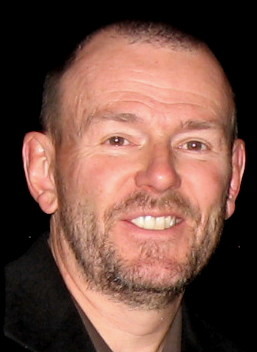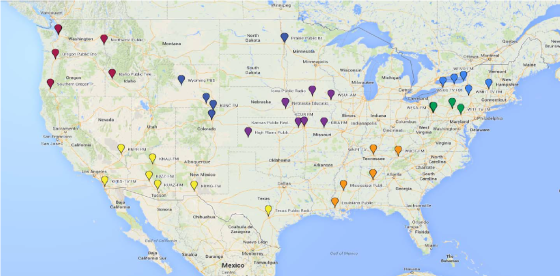
At our June 2014 Media Impact Forum we learned about innovative public media efforts surrounding local journalism (among many other topics). In follow-up to that conversation we chatted with Bruce Theriault, Senior Vice President, Journalism and Radio at the Corporation for Public Broadcasting, to get his take on local journalism efforts, and CPB’s work to support and advance local journalistic excellence.
The data map on the Media Impact Funders’ website details grants of $10,000 and over made by more than 1,000 of the largest US foundations between 2009-2011. That covers a lot and highlights the growth in media-related funding (four times domestic giving in other areas) but it leaves out organizations like CPB, which aren’t foundations.
Since CPB is a major funder in the public media space, can you tell me about some of the funding trends you’re seeing?

CPB is funding numerous journalism initiatives at the local, regional, and national level, with special emphasis on collaborative models in TV and radio. Increasingly we are seeing public media stations collaborate with digital-first news organizations. The Rocky Mountain PBS and I-News merger is a good example. That combination allowed them to pull together a regional collaboration among stations in Wyoming and North Dakota to form a Local Journalism Center (LJC), Inside Energy, which CPB funded this year.
A few years ago we co-funded Project Argo with the Knight Foundation, which enabled us to put resources into stations covering specific topics or beats online through blogs for the first time. We are constantly looking for ways to take those news collaborations to a higher level of impact. Since 2009 we’ve invested over $20 million in journalism — mostly at the local and regional level.
Let’s talk more about local journalism. We heard about the NPR and Kaiser Health News collaboration at our June 4 gathering. What are some other partnerships you are excited about?
We are seeing the LJCs grow and develop into strong go-to resources on their topics. We just funded two news LJCs — Inside Energy (I mentioned earlier) and Keystone Crossroads, with stations across Pennsylvania. Since 2009 we funded nine LJCs and seven still exist. To that end, we are building on the success of the LJC’s by supporting the development of LJC Video Units. Five of the Local Journalism Centers (Fronteras, Harvest Public Media, Innovation Trail, Inside Energy and EarthFix) will create video journalism units at each LJC.
These units will create content which TV stations may use locally, including as news inserts in the NewsHour Weekend edition. In addition, both radio and television stations will now offer more short-form, high quality video news through their websites and mobile apps. This added video news creates the opportunity for more sharing among stations throughout their regions and nationally. This project furthers our goal of building journalism capacity at the station and regional level.
Most recently CPB announced major funding for Upstate Insight, which will create a collaborative regional news model with five public media — WXXI, Rochester; WSKG, Binghamton; WRVO, Oswego; and WMHT, Troy. WBFO in Buffalo is an associate partner.

Above is a map showing the seven LJCs (see larger version). They comprise 55 stations, radio and television —representing large, small, university, community, rural and urban stations: EarthFix (red pins), Fronteras (yellow pins), Harvest (purple pins), Southern Education Desk (orange pins), Keystone Crossroads (green pins), Inside Energy (dark blue pins), and Innovation Trail (blue pins).
As other funders look to support local journalism what wisdom do you want to share?
There’s a lot of interest in sustainability. If you want to see greater impact and sustainability you need to support partnerships, like Rocky Mountain News and I-News and the newly merged St. Louis Public Radio and The Beacon because scale matters.
In addition, we need to develop a journalism strategy at the local level. Most stations news programming just evolved — i.e., it was not based on a comprehensive strategy, but just grew as resources increased. The absence of a local news strategy makes it difficult for stations to partner with other organizations. Few stations are talking about what they want to accomplish in a bigger sense.
I believe that by acting more collaboratively and partnering with other news stations (e.g., LJCs), and some of the best non-profit digital news organizations (e.g., CIR, I-News, Beacon, etc.), public media can create the scale, capacity, and add the new skills needed to produce more high quality original local journalism.
Where is the greatest need for funding — digital, diversity or dialogue?
The three are totally intertwined. Our thinking at CPB is informed by the strategic framework of the 3-D’s – digital, diversity and dialogue. You can’t have full impact without diversity, and that includes audience, reporters, producers, on-air talent, management, etc. Digital is like electricity; it’s everywhere. If you think of yourself as a radio or television station you’re missing the boat. The idea of “we send, you receive” is outdated — the audience is increasingly dictating when and how their media is served. And finally, news stations need to be honest brokers and bring people together in their communities. That convening role and ensuing dialogue is critically important.
All of this requires greater scale or resources, which is why we think strategic alliances among stations and other nonprofit journalism organizations makes sense — because you can’t go it alone. Together we can create something really important.
If our funding map represented CPB investments, what would be the bright spots and what geographic areas would be missing or smaller than you’d like?
There’s pretty good coverage around the country — though the Southern states are lagging a bit. But overall we’re seeing many more stations stepping up, some excellent partnerships and other strategic alliances forming, and several joint licenses beginning to organize their operations as content first, and platform second, which is very promising.
We always believed we could do more together by pooling our resources and there are lots of successes. While we’ve made much progress over the last years, there is still much to accomplish to reach our goal of being the most highly respected, valued and used journalism service for America.